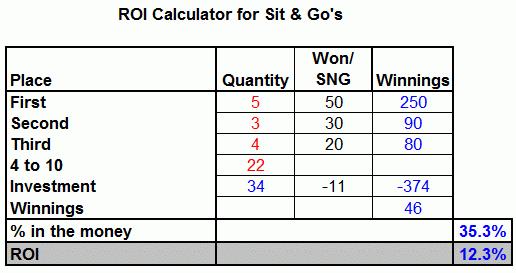Recommended Poker Room
“Return on Investment” is a term that originates from economics and puts the profit into relation to the money invested. The formula is very simple:
Profit
—————– x 100 = ROI (in%)
Investments
Example of a ROI Calculation for Sit and Go Tournaments
Assume you play ten Sit and Go’s with a buy-in of $11 each. You win twice (2 x $50 = $100 profit) and once you become third ($20 profit). The total money you spent (the sum of the tournament buy-ins), e.g. your investment, sums up to a total of 10 x $11 $ = $110. Your total profit is therefore ($100 + $20) – $110 = $10. Your ROI is thus 10/110 * 100 = 9.1%.
Minimum and Maximum ROI in Tournaments
The lowest possible, minimum ROI is -100%: If you play a $11 SnG and lose it, your ROI $ -11 / 11 $ x 100% = -100%. The highest possible, maximum ROI in the short term however can be well over 100%. If you win a $22 MTT and receive $5,000 as a prize money, then your ROI is $4,978 / $22$ x 100% = 22’627%. In 10-handed SNG’s with 10% rake and 50% payout to the winner the highest possible ROI is 355% ($39 / $11 x 100%). Of course even the best players do not achieve such a high ROI, as this is the theoretical limit. As soon as someone only plays a few tournaments, his ROI will decrease to a double digits figure.
Is ROI Important for SNG Players?
While cash game poker players measure their success with big blinds won per hundred hands played (BB/100), for players of poker tournaments such as Sit and Go’s ROI has become the established figure to calculate and to measure the success. A positive ROI is good, a double-digit return on investment is very good.
If you for example have a long-term ROI of 4%, you should indeed continue to work on your poker game skills, but you can also be satisfied that you are one of only few winning players in poker. Don’t forget that the rake of around 10% in SNG tournaments is high and therefore rather difficult to beat. This is also the reason why most tournament players lose money in online poker: the average SNG player has a ROI of minus 9.1% (he invests $11 and wins on average $10, his ROI is -$1 / $11 = -9.1%). Accordingly, a ROI of 4% is about 15 percentage points higher than what an average tournament player achieves.
Hourly Rate (Wage) in Tournaments
If you know your ROI and know how many SNG’s you can play per hour, you can use these figures to calculate your expected average hourly rate: the money you should earn per hour while playing online poker. For example, a player who plays 15 SNG’s per hour with a buy-in of $22 and a ROI of 7% can expect to earn $23.1 per hour (0.07 x 15 x 22).
Sample Size and Observation Period
The variance of the results in Sit and Go tournaments is huge. Calculating the ROI for only a single poker session might be interesting but will not give you a meaningful figure. The more games you play, the more accurate the measured ROI will correspond to the actual ROI. A sample size of 500 (better 1,000 or more) finished SNG’s should be used before you can calculate your ROI with a reasonably statistical relevance. After having played 500 SNG tournaments, the calculated return on investment can still deviate a + / – 10% from the long-term return on investment.
ROI Calculator for SNG and DON
With our free ROI Calculator for Sit and Go and Double or Nothing tournaments you can easily calculate your ROI in an Excel sheet:

Just replace the red figures with your current results to see your ROI and the proportion of “In the Money” rankings.
Download Free ROI Calculator
You can download our free poker ROI calculator by clicking here.


 www.
www.
is the Won/SNG column the percentage of money you win in that particular place corresponding on the right hand side or is it the number of games you played?
Hi Matt
The column “Won/SNG” shows the payout structure. For a 10-handed 11$ SNG, you get 50$ for becoming 1st, 30$ for second place and 20$ for third place. The buy-in (investment) is 11$.